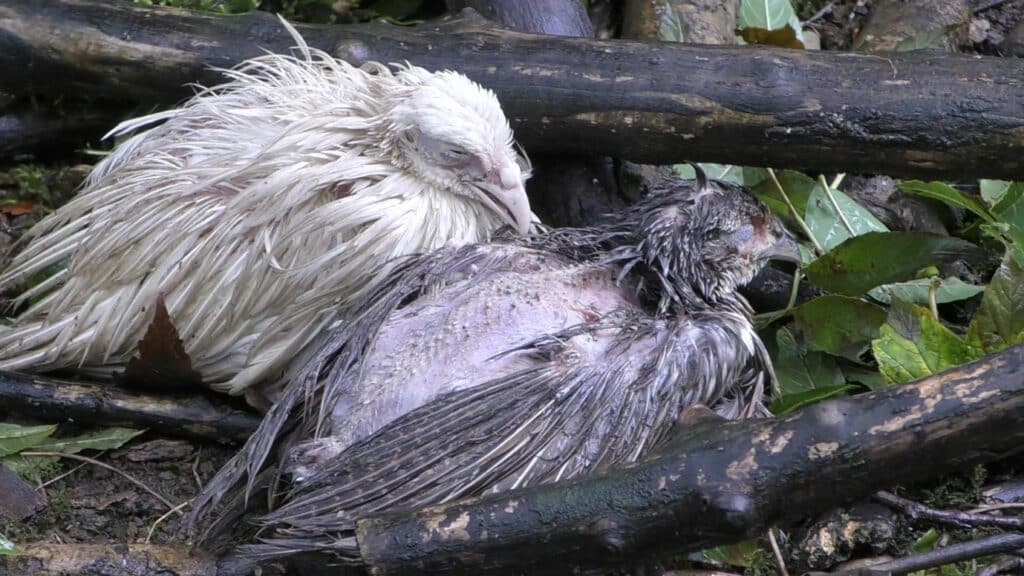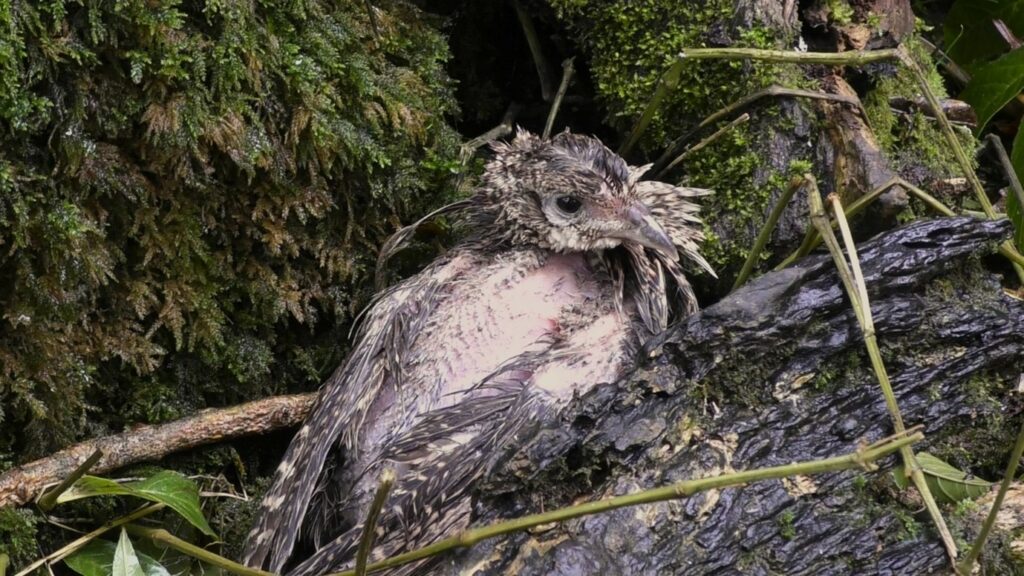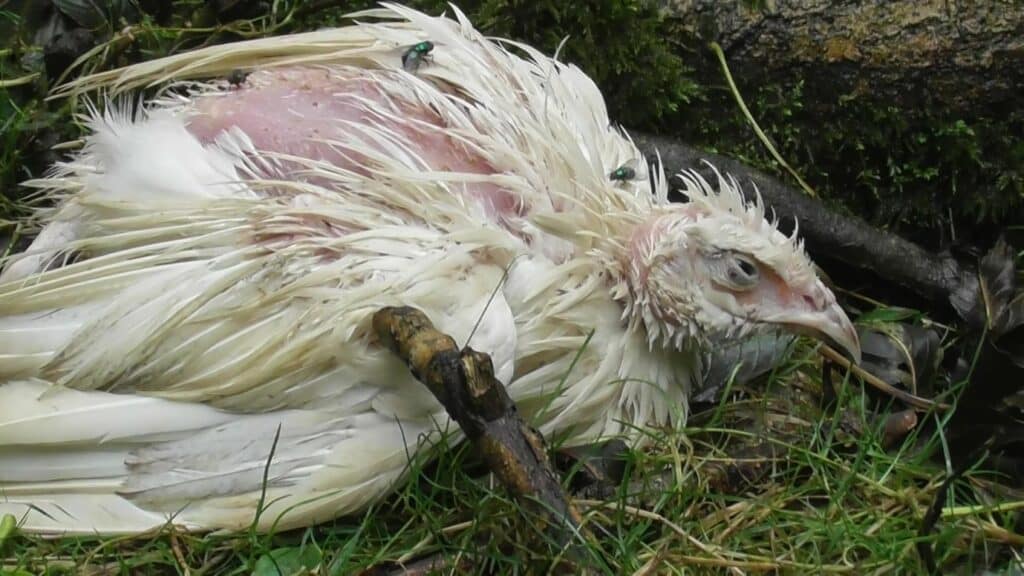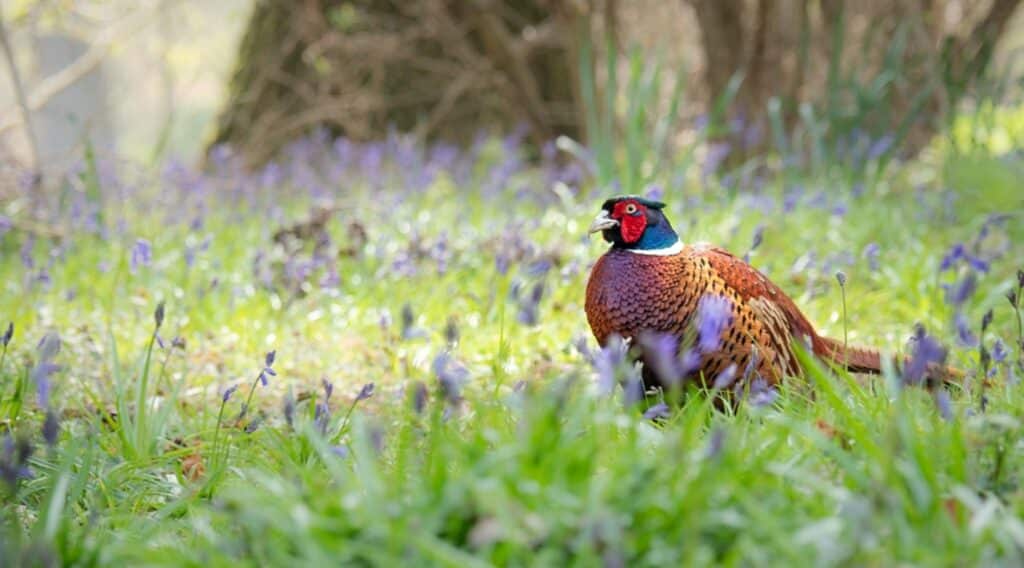Leighton Hall Estate Investigation
Written by Head of Content and pro-wildlife/anti-shooting campaigner Charlie Moores.
In September 2022 Protect the Wild was sent gigabytes of video and photographs filmed by investigators who had visited pheasant pens on the Leighton Hall Estate in Lancashire. We had a rough idea of what to expect, as the investigators themselves – who are highly experienced – had described what they’d seen as shocking and disturbing
It took a day to go through everything. And they were right. We’re still shaken, distressed and extremely angry days later. (Incidentally, editing up this footage was hard enough, but even if investigators can compartmentalise what they’re seeing and remind themselves of the good they can do by getting it online it must have been traumatising to record. They deserve our thanks.)

If you love wildlife and campaign against a ‘hobby’ like shooting, you half know what to expect when an investigation arrives in your inbox. None of it is going to be pleasant. Pheasant chicks crushed together in crates as they’re transported from hatcheries in France, Spain, and Poland to shooting estates in the UK perhaps; snatched footage of diseased poults; adult birds, gloriously vivid and alive one moment exploding in a puff of feathers and lifelessly tumbling out of they sky the next as furiously reloading shooters kill as many of them as they can to get ‘their money’s worth’ before ambling off for a celebratory drink.
You know you’re going to be editing up casual cruelty, selfishness, pain, environmental destruction. Maybe the corpse of a poisoned bird of prey, or occasionally video of a live bird of prey trapped in a cage and being clubbed to death. It’s hard to watch but it’s the reality of an amoral industry. It’s why we work so hard to fight back.
But it is out of the ordinary to get evidence of such extreme suffering on a single estate. On a par, perhaps, with the levels of suffering that campaigners working undercover in abattoirs or on fur farms capture. And it’s unusual to see it recorded so graphically, so much of it, example after example. To know that what you’re looking at can’t be excused by the estate and its managers as ‘a bad day’, that such a heartbreaking lack of compassion and care has to be systemic, everyday, acceptable even.
The short video that we produced shows some of that suffering – not the worst of it, and at most only a few seconds of each case. Like all campaigners we make choices with the viewer in mind. Too graphic it won’t be watched. Too sanitised it has no impact.
What we leave in typically has little room for context or exploration though. Which is the reason for blogs like this.
Leighton Hall Estate, which is managed by Lucy and Danny Arthurs, hosts weddings and corporate events alongside 4×4 driving and pheasant shooting. We don’t know how much revenue shooting brings in, but the Estate is clearly breeding huge numbers of birds to be shot. The Guns On Pegs website lists, for example, an upcoming December shoot with ‘bags’ of over 100 kills at £792 per gun with nine slots available. In reviews, one client discusses “a 100 bird day in November” to celebrate his 30th birthday, another about “generous yields”.
Leighton Hall Estate won’t be alone in serving up hundreds of birds like this. Every year, according to the industry’s own figures, a staggering 40 million Common Pheasants (and up to ten million Red-legged Partridges) are released into the countryside to be shot – so many that if at the start of the shooting season all the individual birds in the UK could be weighed half of the total would be made up of pheasants and partridges alone.

Again according to the industry’s own figures, a quarter of those millions of birds die before shooting even starts.
That might seem extraordinary when shoots are charging so much to kill them, but then again chicks aren’t expensive, keepers aren’t well-paid, and shooting is heavily subsidised by taxpayer-funded grants from the Rural Payments Agency and Natural England (NE) for what is currently termed Countryside Stewardship.
Leighton Hall Estate receives grants which cover the woodlands where their pheasant pens are situated: we don’t have details of specifically what the grants are for but NE routinely funds ‘woodland management’ schemes and barely checks where the money is going. There’s little doubt that shoots are regular beneficiaries of taxpayer support. (This is the same NE, of course, that placates the shooting industry by removing Hen Harrier chicks, one of Britain’s most persecuted birds of prey, from nests on shooting estates rather than do anything about the rampant illegality that has led to the species being almost extirpated from England.)
So, produce a huge surplus of cheap birds for guns happy to celebrate their birthdays by putting holes into living targets and who cares if a few birds get picked off or die of disease along the way. Wastage is embedded into the business model from the outset.
But even if you have that mentality baked in, how can you allow the suffering the investigators witnessed? How can you allow birds to be plucked clean of their feathers. To be gasping for breath, barely alive, as flies crawl over them or stronger birds stand over them attacking them if they move? Everyone knows pheasants fight. They can be vicious and will pick on weaker birds. Breeders know that the colour red invites curiosity across many families of birds (presumably an inherited trait derived from searching for food like fruits and berries) and causes them to peck repeatedly at wounds on other birds. That’s why they use terramycin antibiotics which ‘spray paint’ affected areas blue.
We’re not vets, but there is no evidence whatsoever in the files we saw to suggest any treatment being used to help these birds. The numerous dead bodies attest to that anyway. It’s incredible to us that any ‘professional’ could simply stand by and allow sentient animals to suffer like this. Much in the way, perhaps, that a slaughterman or sealer becomes immune, perhaps familiarity removes compassion. Perhaps you can only serve up birds to shooters when you have stepped so far back from them that they are no longer individuals, no longer living, breathing animals, but simply data points on a profit and loss sheet.

As I wrote above we’re not vets, but like everyone else we know that we’re in the midst of an Avian Flu crisis.
I first learned about Highly Pathogenic Avian Influenza back in the early 2000s when it began to rip through intensively-reared, over-crowded poultry flocks in southern China and South Korea. Rural workers in the vast sheds that housed these unfortunate birds routinely sluiced their waste into steams, washing the H5N1 virus secreted in the birds’ droppings into wetlands that were critically-important to migratory waterfowl. Swans, geese, and ducks began dying in huge numbers, but not before some infected birds apparently managed to spread the virus across East Asia
In 2014 the Korean NGO Birds Korea wrote
“Based on the best available scientific evidence, we continue to believe that it is the industrial production and movement of poultry that has created the conditions required to maintain and spread strains of Highly Pathogenic Poultry Flu; it is the modern poultry industry that causes enormous suffering for billions of animals; and it is the modern poultry industry that has led to a substantial increase in outbreaks of Poultry Flu in wild birds.”
Lessons haven’t been learned of course. Billions of chickens are still raised in unsanitary conditions and – much like the spread of BovineTb into badgers – lax biosecurity controls have allowed the viruses that cause Avian Flu to ‘escape’ into the wild.
And into the birds reared for shooting.
In early September the RSPB asked the government to ban the release of so-called ‘game birds’ into the countryside to stop the spread of Avian Flu. Species Policy Officer Jeff Knott told ITV News that if infected pheasants and partridges were “to transfer bird flu into terrestrial bird populations, into woodland birds, into farmland birds – it would take something that is already a crisis for our sea birds and turn it into a full-blown catastrophe for our wild bird populations across the country.”
Shooting lobbyists, as they so often do, poured an all-too familiar complacent scorn on the RSPB, saying that of course they were being cautious and besides who were a bird charity to harm people’s incomes?
Inevitably, on the 22nd of September, under the headline ‘Pheasants test positive for avian flu as experts warn against release of millions of game birds’, ITV News reported that ‘Data from the Animal Health and Plant Agency reveals for the first time this year that pheasants in Cornwall, Cheshire and Norfolk have tested positive for the H5N1 virus’.
Not just at one site or in one location, but in three counties separated by hundreds of miles. One shooting lobbyist blamed ‘seagulls’. Yeah, that would be it…
Why is this relevant though? Again, we are not vets and we don’t have the facilities to test for Avian Flu, but the footage the investigators captured at Leighton Hall showed excreta-caked water feeders and corpse after corpse after corpse littered across the pens. It would have been indefensible (and illegal) for the investigators to have removed any of the bodies to have them tested and thereby risk potentially spreading disease, but even if this was not down to Avian Flu surely common-sense (let alone some residual sense of decency) would tell you that cleaning the site up and properly disposing of the bodies rather than leaving them to flies and rats or to rot into the soil is at the very least a precaution worth taking.
The owners and managers at Leighton Hall Estate must read the papers, watch the same news as the rest as us. How can they be so casual in such a crisis? The Estate, ten-percent of the Arnside & Silverdale Area of Outstanding Natural Beauty, is near the boundary of the RSPB’s major wetland reserve at Leighton Moss. It’s almost within sight of Morecambe Bay and it’s internationally-important saltmarshes, sands and mudflats. The Bay is one of the top three places in the UK for overwintering birds, along with the Wash and the Ribble Estuaries – the latter just an hour to the south as the goose flies. The birds at Leighton Hall are diseased. If the Estate allows that disease – whatever it is – to spread into these crucially-important landscapes, they should be pilloried from post to post.

Why does Leighton Hall Estate need shooting anyway? Again, we don’t know what revenue it brings in and we don’t know the owners and managers, but the Estate clearly has an interest in biodiversity and the environment. Their website gives that impression anyway, saying that it ‘takes pride in its Environmental & Sustainability projects’ and lists work being done to encourage rare butterflies like the Duke of Burgundy and High Brown Fritillary. They run pollinator projects and want to reintroduce Red Squirrels.
Shooting birds is such a stark contrast to the good work the Estate is doing elsewhere on its land. Besides which as ‘environmentalists’ they must know that pheasants have been recorded catching scarce reptiles like Slow Worms and amphibians, search out caterpillars, and released birds that survive the early winter will take food needed by native seed-eating species during what is called the ‘hungry gap’ when everything is in short supply and wild birds are beginning to enter the breeding season.
They must know, too, that in 2021 Defra (the government department responsible for the environment) acknowledged the damage that all these millions of pheasants might do, especially if released near protected sites or nature reserves, when they added both the Common Pheasant and Red-legged Partridge to Schedule 9 of the Wildlife and Countryside Act, which contains species which cause ecological, environmental or socio-economic harm.
The shooting industry’s release of millions and millions of pheasants has been called an ‘ecological assault’ for good reason. We could ask, just how selfish is it, but we know the answer already. It has built a business on selling birds to disconnected punters to kill. It has seemingly allowed conditions that have lowered the bar on animal welfare so far it’s disappeared underground. It has taken over woodlands and transformed them into unhygienic stockades. And now, despite pleas from scientists and researchers, it has decided it knows better than they do and is risking the spread of a disease that has already wiped out entire seabird colonies and could tear through what remains of our depleted biodiversity. Selfish is such an inadequate term when you think about it.
Shooting lobbyists might well read accounts like this and fall back on the usual tropes of ‘antis’ (for god’s sake how can anyone be ‘for’ this pain and suffering?) and that people like me are ‘emotional’. Of course I’m bloody well emotional. How can anyone look at images like this and not be moved, not to be touched, not become angry. Or ‘emotional’ as shooting likes to disparage what should be a very human reaction to the way these birds are being left to rot.
The shooting industry has shown itself intransigent (it still pumps tonnes of lead into the countryside, an environmental toxin banned in virtually everything else), deaf to common sense arguments, and indifferent to the pain it causes. It needs to go.
